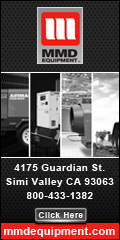ARB Adopts Changes to California’s Truck and Bus Regulation
 Print this Article | Send to Colleague Print this Article | Send to Colleague
The California Air Resources Board (ARB) adopted amendments to its Truck and Bus Regulation that will provide new flexible compliance options to owners of aging diesel fleets and recognize fleet owners that have made investments to comply, while also protecting air quality. The changes approved at the recent Board hearing provide additional regulatory flexibility to small fleets, lower-use vehicles, and fleets in rural areas that have made substantial progress towards cleaner air. Fleets that have invested in cleaner, compliant equipment and trucks will be able to use credits longer and any vehicles retrofit by 2014 do not have to be replaced until 2023.
"We recognize the enormous investments that many businesses have already made to clean up their equipment and abide by the terms of the regulation," said ARB Chairman Mary D. Nichols, "but we are also aware that, particularly for many rural areas of the state, economic recovery has been painfully slow and funding for improvements scarce.
"By providing limited additional time for certain fleets to comply, we believe that we’ll have higher compliance rates overall. It’s a difficult balance but we believe that this is a fair approach that offers flexibility to those who need it, while also rewarding those business owners who have already upgraded their vehicles to meet the requirements of the regulation."
Nichols also said that the amendments, while potentially delaying compliance for some, will still protect air quality, preserving 93% of the NOx (oxides of nitrogen) and diesel particulate matter (PM) benefits of the original regulation.
The amendments include:
- A longer phase-in period for diesel PM requirements for trucks that operate exclusively in certain rural areas with cleaner air;
- Additional time and incentive funding opportunities for small fleets;
- A new compliance option for owners who cannot currently afford compliance;
- Expansion of the low-use exemption and the construction truck extension;
- Recognition of fleet owners who have already complied by providing additional "useable life" for retrofit trucks and reducing near-term compliance requirements.
The amendments will still ensure that, by 2020, nearly every truck in California will have a PM filter, consistent with the goals of the Diesel Risk Reduction Plan.
For more information, please see the April 2014 Proposed Truck and Bus Amendments
Fast Facts on Diesel Emissions:
- Diesel exhaust contains a variety of harmful gases and more than 40 other known cancer-causing compounds. In 1998, California identified diesel particulate matter as a toxic air contaminant based on its potential to cause cancer, premature death and other health problems.
- The Truck and Bus Regulation (Regulation) was adopted in 2008 to clean up harmful emissions from nearly all heavy-duty diesel trucks operating in California. The Regulation was amended in 2010 to provide economic relief to truckers affected by the recession, particularly small fleets, by delaying the first compliance requirements by one year and extending the time the truck could be operated before needing to be replaced.
- Approximately 1 million trucks operate annually on California highways. Roughly 625,000 are based out of state. Of the remaining 400,000 registered in California, about half are in small fleets of three or less.
- The Regulation currently requires most heavy trucks in California to install soot filters or upgrade to newer models with filters by Jan. 1, 2014, and that nearly all trucks have them installed by Jan. 1, 2016.
- For small fleets (three or fewer vehicles), Jan. 1, 2014, was a critical compliance milestone because for the first time at least one vehicle in each fleet needed to comply.
- At its October 2013 meeting, the Board heard an update on the Regulation and agreed with staff’s proposal to move forward with a number of near-term strategies to provide flexibility while not compromising the overall reduction and health benefits to be achieved by the Regulation.
- The changes were developed after some stakeholders voiced concerns regarding their ability to comply with the Regulation at the October 2013 Board hearing. Truckers were able to expand on these concerns at five ARB-sponsored public workshops held across the state in December.
- In 2000, the ARB adopted its Diesel Risk Reduction Plan, a blueprint for developing regulations to address diesel emissions from all sources including garbage trucks, urban buses, construction equipment, port trucks and fuels. For more information, see Diesel Risk Reduction Plan.
- Anyone with questions on current regulatory requirements can visit ARB’s TruckStop website, call 866-6DIESEL or email 8666Diesel@arb.ca.gov.
|
|





